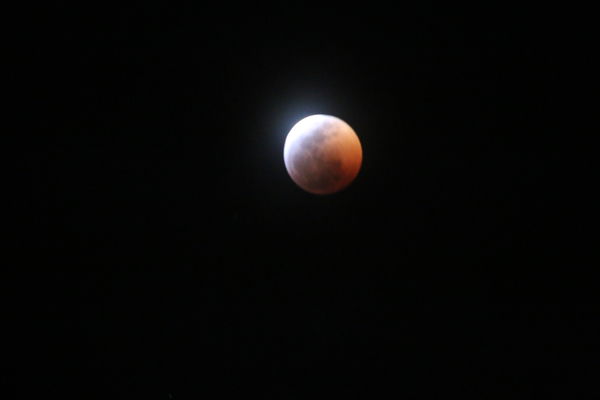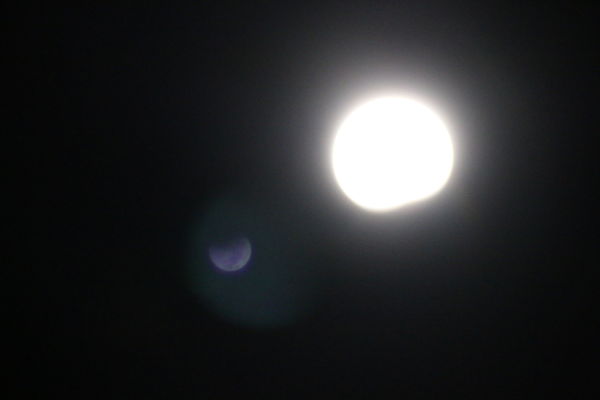More of the full moon and what am i doing wrong
Jan 21, 2019 12:26:21 #
I took these last night and one or so was good. But look at the other and tell me what I did wrong. I am still such an beginner that most of what I shoot is auto.
Jan 21, 2019 12:28:09 #
The second you had metering on "averaging"?
The camera tried to expose the dark, blew out the moon, cause reflections in the lens?
The camera tried to expose the dark, blew out the moon, cause reflections in the lens?
Jan 21, 2019 12:30:30 #
Jan 21, 2019 12:40:04 #
bejamin wrote:
I took these last night and one or so was good. But look at the other and tell me what I did wrong. I am still such an beginner that most of what I shoot is auto.
You need to get out of your comfort zone, get out of auto. The moon is a curious subject for a photographer, it is shot at night, so many think night photography, yet it is a brightly lit orb and should be shot with a lower ISO and faster shutter speed than normal things that would be shot at night. Some even use filters on their lenses to lesson the light and avoid blowing out their photos, as you did in the last shot. If you think you are interested in shooting the moon in the future, practice, the moon is full every month, so make it a habit to take shots throughout the year until you have mastered it. Good luck going forward. Remember, if you want to get better at your photography, get out of your comfort zone. Start with shooting in aperture mode. Search You Tube, they have great videos to teach you. Get out and practice. If you have a wildlife park or plantatarium near you, get out and take photos.
Jan 21, 2019 12:52:06 #
Agree with Longshadow's comments. I'd also guess the ghost might be lens flare. There can be several causes, not using a lens hood, using a narrow aperture, not using a prime lens, etc. There's a lot of info on the Internet which will allow you to experiment. There are also many "How to shoot night shot" articles around that give great advice on capturing the image you seek.
I'd also ask if you were using a tripod? Or was # 2 a handheld shot? It appears the camera moved during the shot, creating an oblong like image of the moon.
Last piece of advice is don't get discouraged ... we've all been there. Photography is challenging.
I'd also ask if you were using a tripod? Or was # 2 a handheld shot? It appears the camera moved during the shot, creating an oblong like image of the moon.
Last piece of advice is don't get discouraged ... we've all been there. Photography is challenging.
Jan 21, 2019 13:02:20 #
wdross
Loc: Castle Rock, Colorado
bejamin wrote:
I took these last night and one or so was good. But look at the other and tell me what I did wrong. I am still such an beginner that most of what I shoot is auto.
Others have mentioned the exposure problem. Also, there are charts on the internet that will give you the proper exposure for the various phases of both lunar eclipses and solar eclipses. That way one can set the camera manually and forget the meter.
As far as the "ghost" image, that is actually lens flare and inverted from the actual image of the moon in the shot. You were overexposed enough that the moon became like the "sun" in your shot and caused the lens flare. It is even easier to see since you have the night sky for a background.
Jan 21, 2019 13:09:54 #
Gang I really appreciate all of your responses. Yes I need to get out of the 'comfort zone' Thanks again. Most of my shots from last night were on my tripod. So thanks again..So TX s l o w learner
Jan 21, 2019 13:15:55 #
If possible/applicable:
1. Be sure to use a tripod
2. Focus manually
3. Use a timer to trip the shutter
4. When using a DSLR lock up the mirror
5. Turn off your "Stabilizer"
6. The following Loony 11 rule below is a great place to start for setting exposures.
I use the Loony 11 Rule:
The “looney 11 rule” states that for astronomical photos of the Moon’s surface, set aperture to f/11 and shutter speed to the (reciprocal of the) ISO film speed (or ISO setting).”
With ISO 100, one sets the aperture to f/11 and the shutter speed to 1/100 or 1/125 second.
With ISO 200, aperture at f/11, set shutter speed to 1/200 or 1/250.
With ISO 400, aperture at f/11, set shutter speed to 1/400 or 1/500.
Enjoy your journey with photography,
JimmyT Sends
Moon Shots: http://www.mreclipse.com/LEphoto/LEphoto.html



1. Be sure to use a tripod
2. Focus manually
3. Use a timer to trip the shutter
4. When using a DSLR lock up the mirror
5. Turn off your "Stabilizer"
6. The following Loony 11 rule below is a great place to start for setting exposures.
I use the Loony 11 Rule:
The “looney 11 rule” states that for astronomical photos of the Moon’s surface, set aperture to f/11 and shutter speed to the (reciprocal of the) ISO film speed (or ISO setting).”
With ISO 100, one sets the aperture to f/11 and the shutter speed to 1/100 or 1/125 second.
With ISO 200, aperture at f/11, set shutter speed to 1/200 or 1/250.
With ISO 400, aperture at f/11, set shutter speed to 1/400 or 1/500.
Enjoy your journey with photography,
JimmyT Sends
Moon Shots: http://www.mreclipse.com/LEphoto/LEphoto.html
bejamin wrote:
I took these last night and one or so was good. But look at the other and tell me what I did wrong. I am still such an beginner that most of what I shoot is auto.



Jan 21, 2019 13:24:09 #
Jimmy
Sounds like you have been at this for quite some time. Your knowledge is very valuable. Thanks.
Sounds like you have been at this for quite some time. Your knowledge is very valuable. Thanks.
If you want to reply, then register here. Registration is free and your account is created instantly, so you can post right away.






